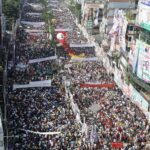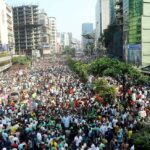Sherlock Holmes famously said that it is a capital mistake to theorise before one has sufficient data. The movement for democracy in Bangladesh has entered a new phase in the past couple of days, and it’s an understatement to say that things are in a flux. However, as this piece is being written (evening of 29 October in Dhaka), we can at least offer a few propositions and conjectures.
First, the easiest and the most obvious one —the violence of the past 36 hours is the sole responsibility of the government. And since nothing in the government happens without the explicit order of the prime minister, the ultimate responsibility for the violence lies with Sheikh Hasina.
Since the late summer of 2022, BNP has had dozens of rallies and meetings across the country. Violence in these events have been perpetrated by the law enforcement agencies or ruling party thugs. Yesterday too the violence was initiated by the heavy-handed police action using tear gas and sound grenades against a peaceful, even festive, crowd in Naya Paltan . Link below.
Everything that has happened since, including the deaths of a Jubo Dal leader, an on-duty policeman, a reporter injured by the tear gas who subsequently died, are a direct result of the police action, the order for which must have come from the very top. So far, four people have died due to the violent crackdown initiated on the afternoon of 28th.
So, the violence befalling Bangladesh is the handiwork of the government in general, and Hasina in particular —this much is clear. What is less clear, however, is why has the regime chosen violence now? October has not ended yet. There are still a lot of days before the election needs to happen. Why push matters to a shove now?
One theory is that the regime panicked. Perhaps the sheer size of the crowd, in spite of various formal and informal obstacles and media blackout, spooked the prime minister.


Perhaps. Perhaps also that the regime feared that BNP would call for a Tahrir Square style sit-in, which would be joined by ordinary and hitherto apolitical people. Fear, they say, is the key. For the last decade, the regime has used fear to suppress the people. Perhaps now it is the prime minister’s heart that is filled with the terror that she might be toppled by the people.
Well, if the regime is afraid that BNP’s activities and programs would attract apolitical citizenry, then the unfolding events seem to make things worse for the prime minister. Today (29 October) has been the most successful hartal the country has seen in well over a decade. No, this is not political spin. We have the data —okay, I apologise for sounding like the prime minister’s son —to show this. Consider the google map of what Dhaka traffic usually looks like on a Sunday afternoon, versus what it looked like today.

In the left, Google traffic map of Dhaka in a typical Sunday 4:00 PM. In the right, traffic map of Dhaka on 29th October, Sunday, the day of the hartal called in protest of the police crackdown.

Images of Dhaka streets and expressways at 11:00 AM during the day of the hartal
This hartal has happened with minimum preparation and little picketing by historical standards. Back when it was the Awami League enforcing hartals, they would have been preceded by torch rallies across the country on the evening prior, and harassments of people going about their lives —the most infamous being the public stripping of a civil servant near the Secretariat in 1995.
Absolutely nothing like that happened today.
The simplest interpretation of events is that the public has silently, but decisively, supported the hartal. If Sheikh Hasina panicked from the crowd size, one wonders how she feels after the hartal.
Ah, but they were afraid, you see, of their vehicles being burnt. Oh, that old bus burning thing! Except now there is incontrovertible evidence of who really is behind the bus burning.
And thus enters the second explanation for the regime’s ham-fisted action. It was all a ruse to crack down on BNP, arrest the top leadership —the Secretary General has already been arrested—and charge them with phantom cases. Hundred years ago, the Raj would throw Mahatma Gandhi, Pundit Nehru and other Congress leaders, and the movement would lose focus, descending into violence and anarchy or just putter out. This might be the gameplan here too.
For example, police communication suggests that there was a ploy to attack the Kakrail Church near the rally in a false flag operation to set up the pretext for a crackdown. As journalist @ZulkarnainSaer reported, a unit of Bangladesh police led by Awami League student leader Ruhani was supposed to conduct a false flag vandalism operation in disguise of BNP men on government and religious establishments but because of high presence of BNP men everywhere, the plan was frustrated.
Perhaps the regime had expected the hartal to flop. Perhaps they hope the oborodhs would be ineffective. Perhaps they hope for violence. Perhaps they would foster violence.
Perhaps. But if today’s hartal is any guide, it is also possible that resolute and yet overall peaceful opposition programs would gather public support. Perhaps the apolitical folks will shake off their apathy, and indeed fear, and support the movement for democracy. The restoration of democracy to Bangladesh is the fight of every single Bangladeshi against Sheikh Hasina. There is no space on the sidelines. To a dictator – every individual is fair game.
The Hasina regime fears the power of the people of Bangladesh. The end of the Hasina regime has never been more proximate. You can feel it in her harsh answers during the press conferences, the MIA status of most of her ministers and MPs, and in the hunger for change in Dhaka.
Fear, really, is the key.


